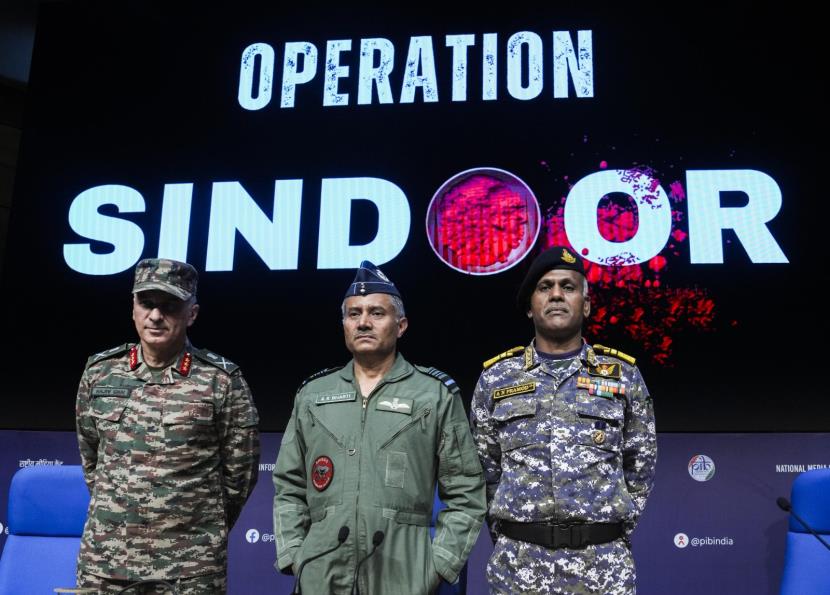Operation Sindoor showcased tri-services synergy: Defence ministry

May 18, 2025
NEW DELHI: India's national security architecture has demonstrated the strength of convergence and strategic foresight during Operation Sindoor, the defence ministry said on Sunday.
The operation showcased a calibrated, tri-services response that embodied precision, professionalism, and purpose, it said.
Operation Sindoor was conceived as a punitive and targeted campaign to dismantle the terror infrastructure across the Line of Control (LoC) and deeper inside Pakistan.
Under the operation, India carried out precision strikes on terror infrastructure early on May 7 in response to the April 22 Pahalgam terror attack.
Following the Indian action, Pakistan attempted to attack Indian military bases on May 8, 9 and 10.
The Pakistani attempts were strongly responded to by the Indian side by inflicting heavy damages to a number of key Pakistani military installations including air bases, air defence systems, command and control centres and radar sites.
Foreign Secretary Vikram Misri on May 10 announced that India and Pakistan reached an understanding to stop all firings and military actions on land, air and sea, with immediate effect.
Throwing light on Operation Sindoor, the defence ministry said India's action in response to the Pahalgam attack was based on "meticulous planning and an intelligence-led approach" which ensured that the operations were conducted with minimal collateral damage.
In the aftermath of the operation, Pakistan initiated a series of retaliatory attacks targeting key Indian airbases and logistics infrastructure.
These attempts, however, were effectively neutralised by India's comprehensive and multilayered air defence architecture, the ministry said.
"Central to this success was the Integrated Command and Control Strategy (ICCS), which facilitated real-time threat identification, assessment, and interception across multiple domains," it said in a statement.
"In every single domain of Operation Sindoor there was operational synergy between the forces and fully supported by the government, agencies and departments," the statement said.
The ministry said the operation "unfolded across land, air, and sea -- a seamless demonstration of synergy between the Indian Army, Air Force, and Navy."
It said the Indian Air Force (IAF) played a crucial role in delivering precision strikes against terror infrastructure across Pakistan.
The IAF conducted high-impact air operations on targets such as the Nur Khan air base and the Rahimyar Khan air base, it said.
The ministry said air force's robust air defence environment proved pivotal in protecting Indian airspace during retaliatory drone and UAV attacks from across the border.
"The indigenously developed Akash surface-to-air missile system and legacy platforms like the Pechora and OSA-AK were deployed effectively in a layered defence grid," it said.
The IAF's integrated air command and control system enabled real-time coordination of air assets, allowing Indian forces to neutralize aerial threats efficiently and maintain net-centric operations throughout the conflict, it added.
Simultaneously, the Indian Army demonstrated its preparedness and effectiveness in both defensive and offensive roles, it said.
The Army's air defence units worked in tandem with the air force, deploying a wide array of systems, the ministry said, adding these units were instrumental in countering waves of drones and loitering munitions launched by Pakistan.
The ministry also highlighted the Indian Navy's role during the operation.
"The Indian Navy played a critical role in asserting maritime dominance during Operation Sindoor. Operating as a composite networked force, the Navy deployed its Carrier Battle Group (CBG) equipped with MiG-29K fighter jets and airborne early warning helicopters. This ensured persistent surveillance and real-time identification of threats across the maritime domain," it said.
"The CBG maintained a powerful air defence shield that prevented hostile aerial incursions, especially from the Makran coast," the ministry said.
It said the Navy's presence created a strong deterrent and effectively bottled-up Pakistani air elements along their western seaboard, denying them any operational space.
"Naval pilots conducted round-the-clock sorties, further demonstrating India's readiness and strategic reach in the region," it said.
"The Navy's ability to establish uncontested control over the seas also validated its anti-missile and anti-aircraft defence capabilities in a complex threat environment," the ministry added.